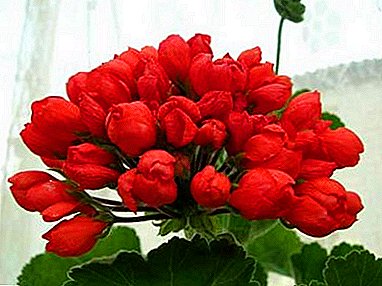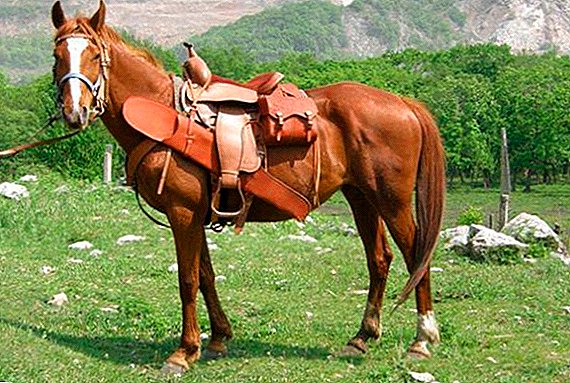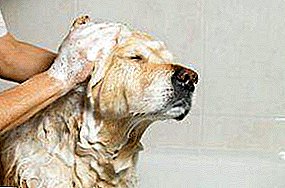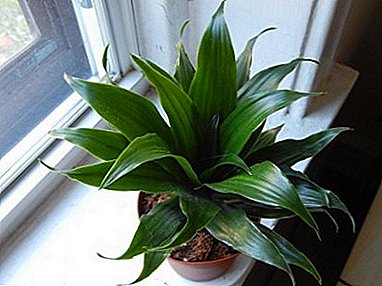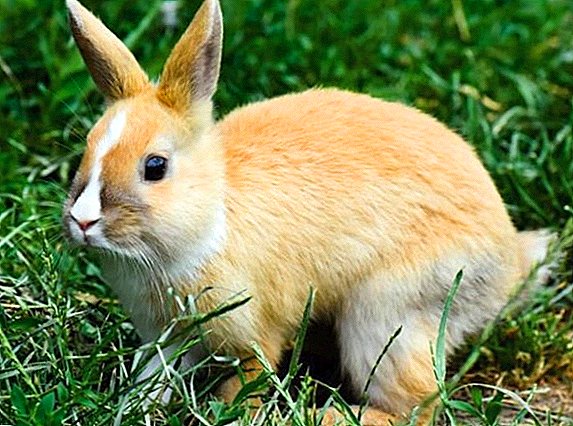 Often, the owners of rabbits are faced with such a phenomenon: in healthy-looking pets, for no reason, convulsions begin. The causes of this problem may be many, but the most likely are the diseases that we will talk about.
Often, the owners of rabbits are faced with such a phenomenon: in healthy-looking pets, for no reason, convulsions begin. The causes of this problem may be many, but the most likely are the diseases that we will talk about.
Encephalosis
Encephalosis is an infectious disease that affects many mammals and birds. The causative agent is Encephalitozoon Cuniculi - a unicellular parasite.
Did you know? Little Idaho (pygmy rabbit) is the smallest breed of this species. The mass of an adult rabbit does not exceed 430 g, and its length is 20-35 cm.
It is believed that the disease is tolerated by spores excreted in the urine. It is possible that many animals become infected in infancy with the milk of an infected mother.
4 weeks after infection, the little rabbit begins to isolate its own controversies. It lasts for 12 weeks and longer. Spores of the disease are quite viable, they can stay in the air for a month, while maintaining their properties.
Characteristic symptoms of the disease:
- convulsive shivering;
- constantly bowed head;
- the animal "pulls" the hind legs;
- the rabbit constantly urinates;
- loss of orientation in space;
- coma.

The most important thing in this situation is to make a diagnosis correctly and in time. They treat the disease with the help of drugs, the main active ingredient of which is fenbendazol. One of such means is Panacur. The main problem is that even after successful treatment with this drug, when the symptoms no longer exist (the convulsions have stopped) and the pathogen has been destroyed, the brain is often already affected.
That is, in this case, the elimination of the cause (the parasite) does not eliminate the effect, the animal still remains sick. Specialists treat it by combining Panacur with potent anti-inflammatory drugs. This measure allows you to suppress the inflammatory processes in the brain.
It is also necessary to give the animal immunomodulators and vitamins of group B. The fact is that potent antibiotics weaken the immune system of the animal.
Important! According to some studies, more than half of all rabbits have had encephalosis or are carriers of it.
Typical treatment of the disease is as follows:
- "Fenbendazol": 20 mg / 1 kg of weight - 1 time per day for 28 days.
- "Dexamethasone": 0.2 mg / 1 kg of body weight - 1 time.
- "Chloramphenicol": 30 mg / 1 kg of body weight - 2 times a day for 14 days, or "Oxytetracycline": 20 mg / 1 kg of body weight for 14 days.
- Vitamins of group B: 0.5-1.0 ml / 1 kg of body weight - once a day for 14 days.
- Droppers ("Sterofundin"): 20-40 mg / 1 kg of weight - once a day for the first 3 days, then every other day for 10 days.
- If necessary, it is necessary to carry out forced feeding.
- Physiotherapy.

You should also examine the animal for pressure sores and carefully examine the condition of the eyes: the development of choroidal inflammation is possible. In this case, you should apply the ointment with cortisone or tetracycline.
A sick animal should not be isolated from its permanent environment if it does not show fear or aggression to other individuals. If changes in behavior are too pronounced, especially as regards the loss of coordination, the patient should be transplanted into a separate cell.
Coccidiosis
The causative agent of the disease is the simplest unicellular - coccidia. The disease affects the intestines and liver of the rabbit. The main risk group is young animals aged 12-16 weeks, but this does not mean that adults cannot become infected.
Did you know? During the period of the Great Geographical Discoveries, the sailors took rabbits with them to ships to set them free on the uninhabited islands. These animals, due to their high productivity and the absence of natural enemies in the new conditions, soon grew to a huge population. Thanks to this, people who by fate turned up on a desert island were provided with food.It is widely believed that the pathogen lives in the body of the animal from birth. This is normal, and should not disturb the owners of rabbits, the main task is not to create favorable conditions for the active development of the parasite.
 A diseased organ can no longer function normally in the digestive system. For this reason, part of the feed will not be assimilated, as a result - the animal will not be able to gain weight.
A diseased organ can no longer function normally in the digestive system. For this reason, part of the feed will not be assimilated, as a result - the animal will not be able to gain weight.Rabbits, which regularly change feed mixtures, are ill most often with coccidiosis. Cases when the animal starts to hurt during the transition from dairy feeding by mother to adult food with mixed feeds can also be included here.
The most common route of transmission of the pathogen is through animal waste (feces). That is, it can be said that the cause of the disease (not the causative agent), like most many others, is unsanitary conditions.
Read more about how to cure coccidiosis in rabbits.
Coccidiosis can be intestinal or hepatic, occur in acute or chronic forms. Acute can manifest itself 2 days after infection. The chronic form manifests itself after the rabbit is already ill and has even recovered. Some of the parasites can remain in the body without harming the digestive tract.  Symptoms of the disease:
Symptoms of the disease:
- diarrhea;
- discharge of blood in feces;
- heat;
- swollen belly;
- lack of appetite;
- eyes and nose fester;
- wool becomes dull, of poor quality;
- sagging belly.
Cramps and tremor are the last stage of the disease. They may occur before the death of the animal.
Important! Even if the treatment of coccidiosis was carried out successfully, and the rabbit recovered, it is still sent for slaughter. There will be no offspring from this animal.Treat coccidiosis as follows:
- "Sulfadimetoksin": 0.2 g / 1 kg of weight - on the first day, then the dosage is reduced to 0.1 g for 4 days. Then make a break in 5 days, after which the course is repeated.
- Phthalazole is used in conjunction with Norsulfazole. Dosage: 0.3 g / 1 kg of the mass of "Norsulfazol" and 0.1 g / 1 kg of the mass of "Ftalazol" for 5 days. Then - 5 days break, after which the course is repeated.
- "Furazolidone": 30 mg / 1 kg of weight 1 time per day for 5 days.
- Baycox is the most effective remedy, in some cases even very advanced forms of the disease can be cured with it. Apply in this way: 2 ml of the drug is given by injection, after which the drug is introduced into the drink (0.2 ml / 1 kg of mass).
- "Levomycetin" and "Sulfadimezin". A sick animal is watered with a solution in a dosage: 40 g of "Levomycetin" and 150 mg of "Sulfadimezin".
Poisoning, intestinal colic
Problems with the digestive tract or poisoning can also cause seizures in an animal. Substances that provoke poisoning can enter the body of an animal with food.
Signs of poisoning:
- refusal to eat;
- depressed state;
- emetic urges;
- mucosa changes color;
- cramping of the limbs.
If the above symptoms are present, you should stop feeding, wash the stomach and, as an antidote, water the animal 4 times a day with milk (preferably with a steam bath) 3 tbsp. l You can razbolat 1 protein chicken eggs in a glass of water and water this means. Helps decoction of flaxseeds or liquid starch jelly.
We recommend to get acquainted with the diseases of rabbits, methods of their treatment and prevention, as well as to learn what diseases of rabbits are a threat to human health.
It should also clear the rabbit's gastrointestinal tract with a laxative and enema. As a laxative, Carlsbad salt is used (4-6 g per 1 head).  Activated carbon (45-50 g / 1 l of water) is given as an absorbent, half a hour after it is taken, a laxative should be given. In case of severe poisoning, it is necessary to give a diuretic and diaphoretic in combination with fortifying and heart drugs.
Activated carbon (45-50 g / 1 l of water) is given as an absorbent, half a hour after it is taken, a laxative should be given. In case of severe poisoning, it is necessary to give a diuretic and diaphoretic in combination with fortifying and heart drugs.
Viral hemorrhagic fever
Viral hemorrhagic disease of rabbits (UHDB) is the most dangerous disease of these animals, which is able to completely destroy the livestock as soon as possible. The cause of the disease is an RNA-containing calicivirus.
Very quickly affects the entire body, is well preserved in the air in the temperature range -40 ... +50 ° C. Resistant to chloroform and ether. The virus concentrates in the liver and skin of the animal.
Diseases are susceptible only to rabbits, for humans (it can be a carrier) and not dangerous for other animals. It is transmitted with food, water, waste, through fur products made from the hides of sick animals.
The incubation period lasts from 1 hour to 3 days. Such a rapid progression of the disease makes it extremely difficult to diagnose and treat. After an animal is infected, the virus enters the bloodstream, through circulation, spreads throughout the body, accumulating in the liver and causing a lethal lesion.  Young animals under the age of 2 months are resistant to the disease, most often it tolerates and recovers normally. At this time, hemorrhagic fever manifested itself is not treated. Vaccination is used to prevent and prevent the disease. But even she cannot absolutely guarantee resistance to the disease.
Young animals under the age of 2 months are resistant to the disease, most often it tolerates and recovers normally. At this time, hemorrhagic fever manifested itself is not treated. Vaccination is used to prevent and prevent the disease. But even she cannot absolutely guarantee resistance to the disease.
After vaccination, the animal is protected already 2.5-3 hours after the procedure. Vaccination is valid for 1 month. There are documented cases when, with the help of vaccination, it was possible to overcome the disease at the earliest stages. However, no vaccine helps with the epidemic of the disease.
Very often VGBK occurs together with myxomatosis, therefore, it is better to vaccinate against these diseases together. The first time vaccination is done at the age of 6 weeks. The next vaccination is 12 weeks later, and then every six months. Injection put in the hips.
We advise you to read about how to choose a rabbit when buying, how to determine the sex of the rabbit, as well as what affects the lifespan and how much the rabbits live on average.
VGBK is extremely dangerous, as a result of its occurrence in one animal often there is an epidemic, as a result - the death of the entire population. The only effective control is regular vaccinations and compliance with necessary sanitary requirements.
Heart failure
Heart failure may occur without symptoms, or it may be accompanied by shortness of breath, general weakness, tachycardia, or seizures. During the period of illness, the heart of an animal can be attacked by certain types of parasites.  This disease is often the result of other diseases, including infectious ones. But more often the cause of heart failure is heart disease: malformations, heart attack, myocarditis, etc. Treatment should be aimed at eliminating the disease that causes heart disease, as well as maintaining liver function and, if there is one, at eliminating pulmonary edema.
This disease is often the result of other diseases, including infectious ones. But more often the cause of heart failure is heart disease: malformations, heart attack, myocarditis, etc. Treatment should be aimed at eliminating the disease that causes heart disease, as well as maintaining liver function and, if there is one, at eliminating pulmonary edema.
Did you know? Some rabbits can snore, and they do it with pleasure.
Hypothermia or overheating
Prolonged exposure of the rabbit to the sun or in a strongly heated room can lead to thermal (sun) shock. In this case, blood in large volumes rushes to the brain of the animal.
It refuses to eat, it appears lethargy in movements, eared can generally lie without movement, breathing becomes frequent and shallow. In severe cases, convulsions and convulsions begin. The rabbit must be taken to fresh air, preferably to a cool place in the shade. A compress bandage should be placed on the head (t - + 14-18 ° C).
The compress should be changed as often as possible, preventing it from heating above the specified temperatures. Homeopathic and homeotoxic agents are used as a treatment. It is believed that animals tolerate cold quite well to -20 ° C, but on the condition that there are no drafts and that they will be dry in their cages.  In the case of hypothermia, you should not carry the rabbit immediately to a warm place, this can lead to serious consequences. It is better to put a hot water bottle wrapped in a towel next to your pet.
In the case of hypothermia, you should not carry the rabbit immediately to a warm place, this can lead to serious consequences. It is better to put a hot water bottle wrapped in a towel next to your pet.
Lack of calcium, magnesium
Calcium is one of the most important trace elements in the body of most animals. The bones and teeth are almost entirely composed of this element. With a lack of calcium in the diet, the body takes it from its own bone tissue. Bones become fragile, subject to fractures.
A lot of calcium is taken from the female rabbits during pregnancy and feeding. The lack of an element in the rabbit's body is expressed in convulsions and can lead to hind leg failure. For treatment, it is necessary to introduce foods rich in calcium in the diet, better than animal origin.
These include:
- meat and bone meal and fish meal;
- powdered milk;
- hardened crushed eggshell;
- purified chalk (can be added to feed).
It will be useful for you to read about what they eat and how to feed rabbits in winter, which branches can be given to rabbits, what grass to feed rabbits, whether rabbits can eat nettle, corn, pumpkin, beets, cereals and bread, and whether rabbits and mugs eat rabbits.
With a lack of magnesium, there is a small mass gain, increased excitability of the animal. If such a feeding regime lasts a long time, it can lead to convulsions and death. To prevent such consequences, magnesium sulphate in the proportion of 35-40 mg / 100 g of feed should be introduced into the diet. 
Today we talked about the most common causes of cramps in rabbits. However, it should be understood that the final and most accurate diagnosis can only be made by a specialist veterinarian.
Important! During the period of pregnancy, it is advisable to introduce calcium-phosphorus veterinary supplements to the rabbit's diet. These include "tricalcium phosphate" and "Kalfostonik".Moreover, in some cases, to confirm the preliminary diagnosis, complex tests (blood biochemistry) or X-rays may be required.






